A Development of Communicative Language Teaching Using Edmodo for Fostering Students’ Skills and Motivation
DOI:
https://doi.org/10.33633/es.v5i01.6255Keywords:
Communicative language teaching; EdmodoAbstract
Abstract. The goals of this research were to establish a communicative language teaching (CLT) approach that used Edmodo as an instructional platform in language learning and to evaluate the technique's efficacy in an English course in terms of writing competence, motivation, and attitude. The researcher also gave alternative ways to support writing tasks with Edmodo through artificial intelligence (computational linguistic or Grammarly). The participants were divided into two groups at random: experimental and control. The total of the sample in this research was 40 students. The subjects in this research were junior high school students in the first grade. The students in the experimental group were instructed by a communicative language teaching approach supported by using online learning (Edmodo); while, students in the control group were implemented regular teaching instruction. The findings indicated that communicative language teaching could significantly improve the students' writing skills compared with those who were not exposed to such a method. Specifically, students who were exposed to Edmodo in Communicative language teaching could achieve a higher score and showed a good motivation to learn English compared with those who were not exposed to the communicative language teaching method. Using Edmodo supported by artificial intelligence tools became one of the innovative ways to conduct more effective teaching in English language teaching.Keywords: Communicative language teaching, EdmodoAbstrak. Tujuan dari penelituan ini adalah untuk mengembangkan communicative language teachinf (CLT) dalam penggunaan Edmodo sebagai alat pembelajaran dalam belajar bahasa dan menguji keefektifan dari metode yang diimplementasikan di pelajaran bahasa Inggris terkait dalam kemampuan menulis, motivasi dan sikap. Peneliti juga memberikan cara alternatif untuk mendukung tugas menulis dengan Edmodo melalui kecerdasan buatan (commputational linguistic dan grammarly. Siswa dibagi 2 kelompok: grup eksperimental dan grup kontrol. Jumlah dari sampel di penelitian sebanyak 40 siswa. Sampel penelitian ini adalah siswa kelas I SMP. Siswa pada kelompok eksperimen menerapkan metode pengajaran bahasa komunikatif yang didukung dengan pembelajaran online Edmodo; sedangkan, siswa dalam kelompok kontrol diimplementasikan instruksi pengajaran reguler. Temuan menunjukkan bahwa siswa diajarkan pengajaran bahasa komunikatif lebih efektif daripada pengajaran pengajaran biasa. Temuan menunjukkan bahwa pengajaran bahasa komunikatif dapat secara signifikan meningkatkan keterampilan menulis siswa dibandingkan dengan mereka yang tidak terkena metode tersebut. Secara khusus, siswa yang di ajarkan Edmodo dalam pengajaran bahasa Komunikatif dapat mencapai skor yang lebih tinggi dan menunjukkan motivasi yang baik untuk belajar bahasa Inggris dibandingkan dengan mereka yang tidak diberikan metode pengajaran bahasa komunikatif. Menggunakan Edmodo dengan didukung oleh alat kecerdasan buatan menjadi salah satu cara inovatif untuk melakukan pengajaran yang lebih efektif dalam pengajaran bahasa Inggris. Kata kunci: pengajaran bahasa komunikatif, EdmodoReferences
Adas, D., & Bakir, A. (2013). Writing Difficulties and New Solutions?: Blended Learning as an Approach to Improve Writing Abilities.
International Journal of Humanities and Social Science, 3(9), 254–266.
Ahangari, S., & Babapour, M. (2015). the Effect of Self-Correction and Peer-Correction on Efl Learners ’ Writing. Modern Journal of Language Teaching Methods, 5(2), 465–473.
Al-Essa, N. S. (2018). The Impact of Using Edmodo as a Blended Learning Medium on Promoting Saudi EFL Female Secondary School Students’ English Grammar. Arab World English Journal, 221, 1–112. https://doi.org/10.24093/awej/th.221
Ermawanti, L. (2017). The Use of Edmodo in Teaching Process of Writing Skill at the Eleventh Grade Students of SMA Muhammadiyah 1 Klaten Academic Year 2016/2017. Tesis.
Fraenkel, J. R., & Wallen, N. E. (2009). How to Design And Evaluate Research in Education.
Harmer, J. (1998). How to teach English: An introduction to the practice of English teaching. England: Adison Wesley Longman.
Inel Ekici, D. (2017). The Use Of Edmodo In Creating An Online Learning Community Of Practice For Learning To Teach Science. Malaysian Online Journal of Educational Sciences, 5(2), 91–106.
Lara, V. D. (2013). The improvement of writing based on a genre approach through the use of an e-learning platform.
Marczyk, G., DeMatteo, D., & Festinger, D. (2005). Essentials of Research Design and Methodology. In John Wiley & Sons, Inc. https://doi.org/10.18488/journal.10/2017.6.3/10.3.48.57
Miftah, M. Z. (2018). Utilization of Edmodo as an Online Tool in EFL Writing Class to Increase Students’ Writing Ability. Register Journal, 11(1), 37. https://doi.org/10.18326/rgt.v11i1.37-58
Muhlis, A. (2017). Potentials and Challenges of Using Edmodo Postings on Efl Reading Activity: Teacher and Students’ Perception. 2nd NEDS Proceedings, 2(1), 25–39. http://english.stkipbjm.ac.id/wp-content/uploads/2017/06/Azhari-Muhlis.pdf
Nishanthi, R. (2018). The importance of learning English in today world. International Journal of Trend in Scientific Research and Development, 3(1), 871-874.
Nunan, D., Terrell, T. D., & Brown, H. D. (2003). Practical English Language Teaching. In Language (Vol. 57, Issue 3).
Pop, A. (2013, October). Edmodo e-portfolios in EFL–A case study. In 8th International Conference on Virtual Learning (pp. 25-26).
Richards, J. C., & Rodgers, T. S. (1986). Approaches and Methods in Language Teaching. In The Canadian Modern Language Review. https://doi.org/10.3138/cmlr.44.3.551
Thongmak, M. (2013). Social Network System in Classroom: Antecedents of Edmodo © Adoption. Journal of E-Learning and Higher Education, 2013, 1–15. https://doi.org/10.5171/2013.657749





















